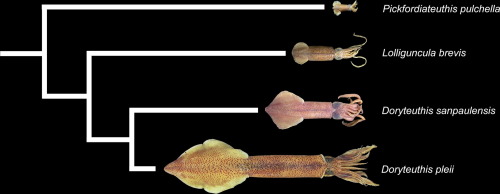当前位置:
X-MOL 学术
›
Mol. Phylogenet. Evol.
›
论文详情
Our official English website, www.x-mol.net, welcomes your
feedback! (Note: you will need to create a separate account there.)
The grass squid Pickfordiateuthis pulchella is a paedomorphic loliginid.
Molecular Phylogenetics and Evolution ( IF 3.6 ) Pub Date : 2020-03-23 , DOI: 10.1016/j.ympev.2020.106801 Frank E Anderson 1 , José Eduardo A R Marian 2
Molecular Phylogenetics and Evolution ( IF 3.6 ) Pub Date : 2020-03-23 , DOI: 10.1016/j.ympev.2020.106801 Frank E Anderson 1 , José Eduardo A R Marian 2
Affiliation

|
The wide disparity in adult body size observed both within and among animal taxa has long attracted widespread interest, with several general rules having been proposed to explain trends in body size evolution. Adult body size disparity among the cephalopod mollusks is remarkable, with adult body sizes ranging from a few centimeters to several meters. Some of the smallest cephalopods are found within Pickfordiateuthis, a group comprising three described species of squid found in the western Atlantic and tropical eastern Pacific. Pickfordiateuthis pulchella, the type species of the genus, was initially proposed to be closely related to the loliginid squids (Loliginidae), with subsequent descriptions of additional species supporting a placement within Loliginidae. Pickfordiateuthis is remarkable in that all species reach sexual maturity at about one-fifth to one-tenth the size seen in most loliginid species. To date, no phylogenetic analyses have included representatives of Pickfordiateuthis. To infer the phylogenetic position of Pickfordiateuthis and explore its implications for body size evolution, we collected specimens of Pickfordiateuthis pulchella from Brazilian waters and sequenced regions of two loci-the mitochondrial large ribosomal subunit (rrnL a.k.a. 16S) gene and the nuclear gene rhodopsin. Maximum likelihood and Bayesian analyses of these sequences support a placement of Pickfordiateuthis pulchella as sister to a clade comprising the Western Hemisphere loliginid genera Doryteuthis and Lolliguncula. Analyses of body size evolution within Loliginidae suggest that a shift to a smaller body size optimum occurred along the lineage leading to P. pulchella, with some evidence of shifts toward larger sizes in the ancestors of Loligo and Sepioteuthis; these inferences seem to be robust to phylogenetic uncertainty and incomplete taxon sampling. The small size and juvenile-like morphological traits seen in adult Pickfordiateuthis (e.g., sepiolid-like fins and biserial sucker arrangement in the tentacles) may be due to paedomorphosis.
中文翻译:

乌贼Pickfordiateuthis pulchella是一种古猿类鳞茎。
长期以来,在动物类群内和动物群之间观察到的成年人体重差异很大,引起了广泛的兴趣,已经提出了一些通用规则来解释人体大小演变的趋势。头足类软体动物之间的成人体型差异非常明显,成人体型范围从几厘米到几米。在Pickfordiateuthis内发现了一些最小的头足类动物,该类包括三个在西大西洋和热带东太平洋发现的鱿鱼种。最初提出的Pickfordiateuthis pulchella是该属的典型物种,它与loliginid鱿鱼(Loliginidae)密切相关,随后对支持在Loliginidae中放置的其他物种进行了后续描述。Pickfordiateuthis的显着之处在于,所有物种都达到了性成熟,其大小约为大多数狼蛛类物种的五分之一至十分之一。迄今为止,还没有系统发育分析包括Pickfordiateuthis的代表。为了推断Pickfordiateuthis的系统发育位置并探讨其对体型进化的影响,我们从巴西水域和两个基因座的线粒体大核糖体亚基(rrnL aka 16S)基因和核基因视紫红质的测序区域中收集了Pickfordiateuthis pulchella的标本。这些序列的最大似然法和贝叶斯分析法支持Pickfordiateuthis pulchella作为包含西半球狼蛛属Doryteuthis和Lolliguncula的进化枝的姐妹。Loliginidae体内大小演变的分析表明,沿着导致P.chulchella的谱系发生了向较小的最佳体重的转变,一些证据表明Loligo和Sepioteuthis的祖先向较大的大小转变。这些推论似乎对系统发育不确定性和不完整的分类群采样具有鲁棒性。在成年的Pickfordiateuthis身上见到的小尺寸和类似青少年的形态特征(例如,触角上的海豹类鳍和双吸盘排列)可能是由于幼虫变态。
更新日期:2020-03-26
中文翻译:

乌贼Pickfordiateuthis pulchella是一种古猿类鳞茎。
长期以来,在动物类群内和动物群之间观察到的成年人体重差异很大,引起了广泛的兴趣,已经提出了一些通用规则来解释人体大小演变的趋势。头足类软体动物之间的成人体型差异非常明显,成人体型范围从几厘米到几米。在Pickfordiateuthis内发现了一些最小的头足类动物,该类包括三个在西大西洋和热带东太平洋发现的鱿鱼种。最初提出的Pickfordiateuthis pulchella是该属的典型物种,它与loliginid鱿鱼(Loliginidae)密切相关,随后对支持在Loliginidae中放置的其他物种进行了后续描述。Pickfordiateuthis的显着之处在于,所有物种都达到了性成熟,其大小约为大多数狼蛛类物种的五分之一至十分之一。迄今为止,还没有系统发育分析包括Pickfordiateuthis的代表。为了推断Pickfordiateuthis的系统发育位置并探讨其对体型进化的影响,我们从巴西水域和两个基因座的线粒体大核糖体亚基(rrnL aka 16S)基因和核基因视紫红质的测序区域中收集了Pickfordiateuthis pulchella的标本。这些序列的最大似然法和贝叶斯分析法支持Pickfordiateuthis pulchella作为包含西半球狼蛛属Doryteuthis和Lolliguncula的进化枝的姐妹。Loliginidae体内大小演变的分析表明,沿着导致P.chulchella的谱系发生了向较小的最佳体重的转变,一些证据表明Loligo和Sepioteuthis的祖先向较大的大小转变。这些推论似乎对系统发育不确定性和不完整的分类群采样具有鲁棒性。在成年的Pickfordiateuthis身上见到的小尺寸和类似青少年的形态特征(例如,触角上的海豹类鳍和双吸盘排列)可能是由于幼虫变态。




















































 京公网安备 11010802027423号
京公网安备 11010802027423号